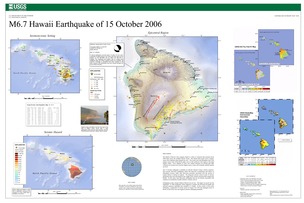Poster of the Hawaii Earthquake of 15 October 2006 - Magnitude 6.7
Tectonic Summary
The Island of Hawaii is the youngest island in a chain of volcanoes that stretches about 3500 miles across the northern Pacific Ocean. The island chain results from a magma source that originates deep beneath the crust. The ocean crust and lithosphere above the magma source, within the Pacific tectonic plate, move to the northwest with respect to the deep magma source. Over millions of years, new island volcanoes are formed and older volcanoes are carried away from the magma source, erode, and eventually subside beneath sea level.
The 15 October earthquake is probably not directly related to future volcanic eruptions. Non-volcanic Hawaiian earthquakes reflect the long-term accumulation and release of lithospheric stresses, rather than short-term processes associated with the motion of magma before or during an eruption. The long-term stresses consist in part of stresses generated in the crust and mantle by the weight of the volcanic rock that composes the islands. In that sense, most Hawaiian earthquakes that are not directly associated with eruptions are nonetheless broadly related to volcanic activity.
Earthquakes on the volcanic Island of Hawaii are not rare. The largest on record was the magnitude 7.9 1868 earthquake near the south coast which triggered a tsunami that drowned 46 people and which spawned numerous landslides that resulted in 31 deaths. A magnitude 6.9 tremor on August 21, 1951, damaged scores of homes on the Kona coast and triggered numerous damaging landslides.
Downloads

Settings
The posters may be downloaded for viewing or for printing on a color
plotter. Adobe PDF (.pdf) format files are provided. Adobe Acrobat 6.0 or
higher is required for viewing the PDF file on a computer monitor and for
printing the PDF map graphic. IMPORTANT: The PDF map graphic was produced
using TrueType fonts; change the following setting to:
Page(Print)Setup<Properties<Layout<Advanced<Graphic<TrueTypeFont<DownloadAsSoftFont
Attention MAC users: If you have problems viewing the pdf files, please download the pdf file and view it in the lastest verion of Adobe Acrobat.

